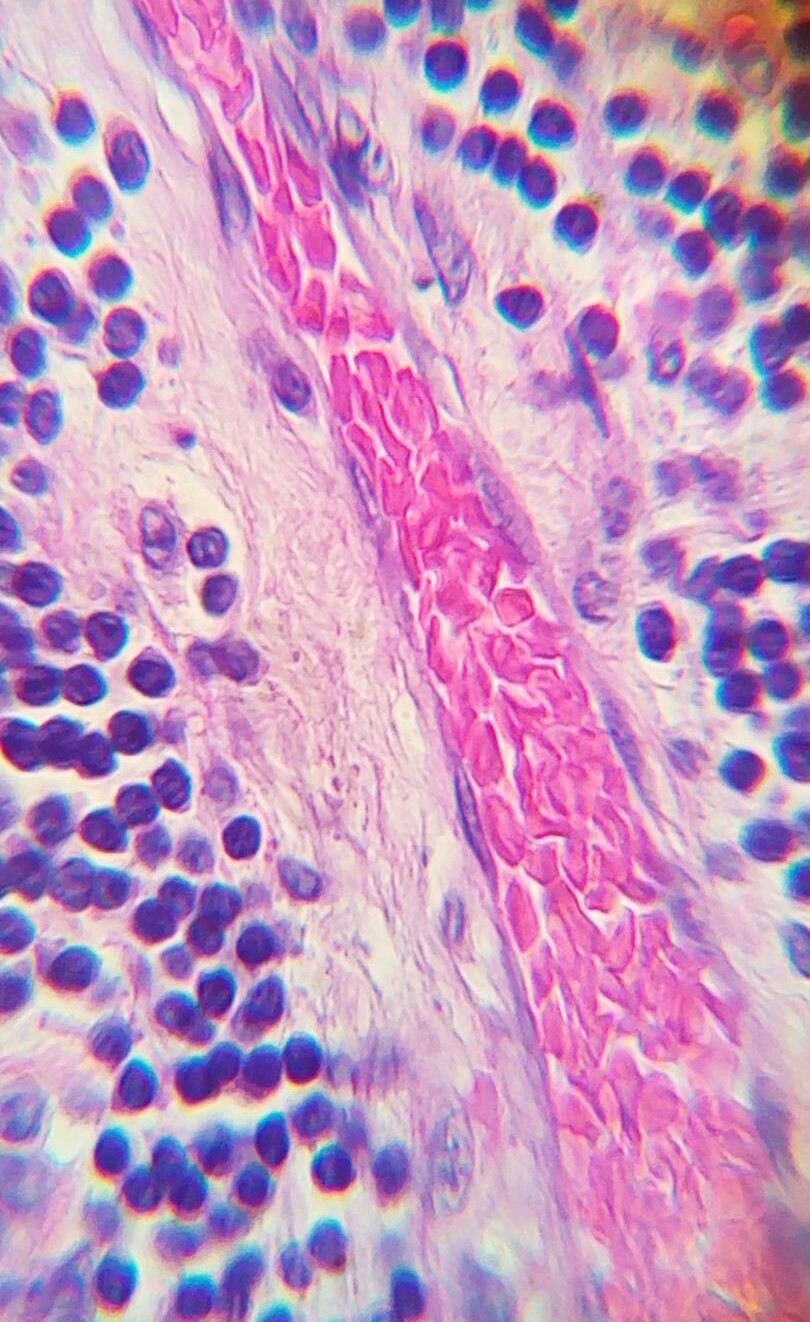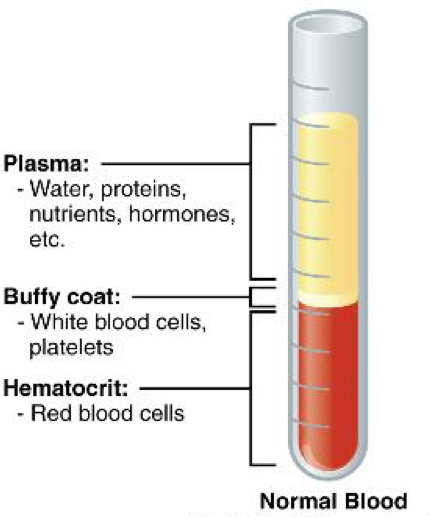Functions of Blood
Objective 1
Characterize the properties of the blood that make it a connective tissue, and describe the general functions of the blood. Describe its physical characteristics. Identify and describe the components of whole blood.
Functions of Blood
Blood is one component of the cardiovascular system, the others being the heart and blood vessels. As the body’s transport medium, the blood provides a means to transport oxygen, carbon dioxide, hormones, nutrients, and waste. The blood also contains most of the cells, proteins, and chemicals required to initiate and support resistance to diseases. Body temperature and pH are also regulated by the blood.
All connective tissues share similar properties: they have cells and an extracellular matrix. Blood fits these criteria. The blood contains various types of cells and cell fragments, referred to as formed elements, suspended in an extracellular matrix called plasma.
The blood has three basic functions: transportation, regulation, and protection. Each of the individual components of the blood has a specific function. Together, they provide a very efficient means of delivering nutrients and removing wastes to and from all areas of the body. Every cell in the body requires a continuous supply of oxygen and nutrients. Restricting the blood supply to a tissue, even for a short period of time, will result in some amount of cellular death. This is exactly what happens in the majority of heart attacks or strokes; the blood supplies to the heart or brain become blocked and the cells are injured or die as a result.
The way the blood delivers nutrients to cells and organs throughout the body and removes waste by delivering it to the kidneys is similar to how you regulate the environment in your home. Imagine if you didn’t buy groceries or take out the trash for several weeks. Things would get uncomfortable quickly. In a similar way, the blood plays a key role in ensuring the cells and tissues have the oxygen and nutrients they need while removing the CO2 and waste products that could be harmful if allowed to build up.
 Working with the lymphatic system, the blood helps to facilitate the immune response by allowing necessary cells, proteins, and other chemicals to circulate throughout the body. These cells and other components patrol the body looking for invaders, joining in the fight if infection has already begun.
Working with the lymphatic system, the blood helps to facilitate the immune response by allowing necessary cells, proteins, and other chemicals to circulate throughout the body. These cells and other components patrol the body looking for invaders, joining in the fight if infection has already begun.
While almost everyone has seen their own blood at some point, few fully understand what is actually in that blood and why it appears the way it does. Because blood is more than just a fluid, it is logical that it would be thicker or more viscous than water and other fluids throughout the body. The blood plays a role in helping to dissipate or conserve heat, depending on body temperature changes. Like fluid in a radiator, the temperature of the blood as it circulates through the body is both the result of and a direct influence on the overall body temperature. The pH of the blood is maintained at a constant 7.35 to 7.45, slightly more alkaline than pure water. Depending on the oxygenation of the hemoglobin in the blood, the color of it can range from a darker to brighter red. Arterial blood is a brighter red than venous blood due to the presence of more oxygen. The volume of total blood in the body varies with sex, body mass, and hydration status, but is typically between 4-6 liters. Changes in blood volume can have dramatic effects on the body’s ability to maintain homeostasis.
Blood has two main components, the formed elements (mostly cells) and plasma. The term formed elements sounds like a weird term for the cellular components of the blood, but it is accurate. The formed elements consist of the red blood cells (erythrocytes), the white blood cells (leukocytes) and the platelets (thrombocytes). The reason they are called formed elements is because of the platelets. Platelets aren’t cells, they are fragments of larger cells called megakaryocytes.
The blood that is most often used for testing in a clinical situation is removed from a vein, usually in the antebrachial region of the arm, through venipuncture. The blood that enters the phlebotomy tubes is called whole blood, meaning it hasn’t been separated into individual parts. When a tube of whole blood is spun in a centrifuge, the denser cells will sink to the bottom of the tube, leaving the less dense plasma on top. The formed elements account for about 45% of the total volume, with the red blood cells accounting for almost all of that. Females tend to have a lower average hematocrit because of the blood loss that accompanies menstruation as well as differences in body mass and composition. The percentage of whole blood that is formed elements is called the hematocrit.
Plasma accounts for the other 55%. There are many situations where we need to give patients components of blood. Transfusion medicine, sometimes called immunohematology, concerns itself with the safe preparation and infusion of red blood cells, platelets, or plasma. When a person donates blood, their donation is separated into a plasma component as well as a packed red blood cell component. Special donation procedures are required to obtain enough platelets for transfusion.
 Blood plasma is a clear, yellow liquid. It is 92% water and 8% solutes. The majority of the solutes (7 of the 8%) are plasma proteins.
Blood plasma is a clear, yellow liquid. It is 92% water and 8% solutes. The majority of the solutes (7 of the 8%) are plasma proteins.
There are many types of plasma proteins, with many different functions. Most frequently they are carrier molecules, but collectively, they contribute to the osmotic balance of the blood. The hepatocytes of the liver produce the majority of the plasma proteins. They include albumin (54%), the globulins (38%) and fibrinogen (7%), a clotting protein. The remaining 1% of plasma is made up of miscellaneous solutes: electrolytes, nutrients, gases, hormones, and waste products.
One important type of globulins are the immunoglobulins, also known as antibodies. These plasma proteins are produced in response to antigens, organic molecules that the body recognizes as foreign. They serve as flags so the immune system knows what needs to be destroyed.
As previously mentioned, the formed elements consist of the red blood cells, white blood cells, and platelets. Each of these along with the immune system components will be addressed in detail later in this unit.
Media Attributions
- U15-001 Blood Vessel Fixed and Stain © Tapia, Jesus Leonardo Rondon is licensed under a CC BY (Attribution) license
- U15-002 Composition of Blood © Betts, J. Gordon; Young, Kelly A.; Wise, James A.; Johnson, Eddie; Poe, Brandon; Kruse, Dean H. Korol, Oksana; Johnson, Jody E.; Womble, Mark & DeSaix, Peter adapted by Jim Hutchins is licensed under a CC BY (Attribution) license

